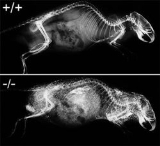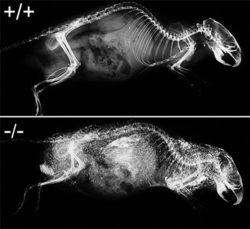
Fetuin
Encyclopedia

Blood proteins
Blood proteins, also termed serum proteins or plasma proteins, are proteins found in blood plasma. Serum total protein in blood is 7g/dl...
that are made in the liver
Liver
The liver is a vital organ present in vertebrates and some other animals. It has a wide range of functions, including detoxification, protein synthesis, and production of biochemicals necessary for digestion...
and secreted into the blood stream. They belong to a large group of binding protein
Protein
Proteins are biochemical compounds consisting of one or more polypeptides typically folded into a globular or fibrous form, facilitating a biological function. A polypeptide is a single linear polymer chain of amino acids bonded together by peptide bonds between the carboxyl and amino groups of...
s mediating the transport and availability of a wide variety of cargo substances in the blood stream. The best known representative of these carrier proteins is serum albumin
Serum albumin
Serum albumin, often referred to simply as albumin is a protein that in humans is encoded by the ALB gene.Serum albumin is the most abundant plasma protein in mammals. Albumin is essential for maintaining the osmotic pressure needed for proper distribution of body fluids between intravascular...
, the most abundant protein in the blood plasma
Blood plasma
Blood plasma is the straw-colored liquid component of blood in which the blood cells in whole blood are normally suspended. It makes up about 55% of the total blood volume. It is the intravascular fluid part of extracellular fluid...
of adult animal
Animal
Animals are a major group of multicellular, eukaryotic organisms of the kingdom Animalia or Metazoa. Their body plan eventually becomes fixed as they develop, although some undergo a process of metamorphosis later on in their life. Most animals are motile, meaning they can move spontaneously and...
s. Fetuin is more abundant in fetal blood, hence the name "fetuin" (from Latin, fetus). Fetal calf serum contains more fetuin than albumin, while adult serum contains more albumin than fetuin.
Family members
HumanHuman
Humans are the only living species in the Homo genus...
fetuin is synonymous with α2-HS-glycoprotein (genetic symbol AHSG), α2-HS, A2HS, AHS, HSGA, and fetuin-A. Fetuin-A exists as a single-copy gene in the human and mouse genomes. A closely related gene, fetuin-B, also exists in the human, rat
Rat
Rats are various medium-sized, long-tailed rodents of the superfamily Muroidea. "True rats" are members of the genus Rattus, the most important of which to humans are the black rat, Rattus rattus, and the brown rat, Rattus norvegicus...
, and mouse
Mouse
A mouse is a small mammal belonging to the order of rodents. The best known mouse species is the common house mouse . It is also a popular pet. In some places, certain kinds of field mice are also common. This rodent is eaten by large birds such as hawks and eagles...
genome
Genome
In modern molecular biology and genetics, the genome is the entirety of an organism's hereditary information. It is encoded either in DNA or, for many types of virus, in RNA. The genome includes both the genes and the non-coding sequences of the DNA/RNA....
s. Like fetuin-A, fetuin-B is made predominantly by the liver and to a lesser extent by a number of secretory tissues
Biological tissue
Tissue is a cellular organizational level intermediate between cells and a complete organism. A tissue is an ensemble of cells, not necessarily identical, but from the same origin, that together carry out a specific function. These are called tissues because of their identical functioning...
. Fetuins exist in all vertebrate genomes including fish
Fish
Fish are a paraphyletic group of organisms that consist of all gill-bearing aquatic vertebrate animals that lack limbs with digits. Included in this definition are the living hagfish, lampreys, and cartilaginous and bony fish, as well as various extinct related groups...
and reptile
Reptile
Reptiles are members of a class of air-breathing, ectothermic vertebrates which are characterized by laying shelled eggs , and having skin covered in scales and/or scutes. They are tetrapods, either having four limbs or being descended from four-limbed ancestors...
s. Fetuins are members of a family of proteins that evolved from the protein cystatin
Cystatin
The cystatins are a family of cysteine protease inhibitors with homology to chicken cystatin. Cystatins typically comprise about 115 amino acids, are largely acidic, contain four conserved cysteine residues known to form two disulfide bonds, may be glycosylated and/or phosphorylated, with...
by gene
Gene
A gene is a molecular unit of heredity of a living organism. It is a name given to some stretches of DNA and RNA that code for a type of protein or for an RNA chain that has a function in the organism. Living beings depend on genes, as they specify all proteins and functional RNA chains...
duplication and exchange of gene segments. Fetuins thus belong to the cystatin superfamily of proteins. Fetuin relatives within this superfamiliy are the histidine
Histidine
Histidine Histidine, an essential amino acid, has a positively charged imidazole functional group. It is one of the 22 proteinogenic amino acids. Its codons are CAU and CAC. Histidine was first isolated by German physician Albrecht Kossel in 1896. Histidine is an essential amino acid in humans...
-rich glycoprotein (HRG) and kininogen (KNG).
Animal studies
The function of Fetuin-A in the body was determined by gene knockout technology in mice. Knocking out the gene for fetuin-A rendered the mice completely fetuin-A deficient. Feeding a mineralMineral
A mineral is a naturally occurring solid chemical substance formed through biogeochemical processes, having characteristic chemical composition, highly ordered atomic structure, and specific physical properties. By comparison, a rock is an aggregate of minerals and/or mineraloids and does not...
-rich diet
Diet (nutrition)
In nutrition, diet is the sum of food consumed by a person or other organism. Dietary habits are the habitual decisions an individual or culture makes when choosing what foods to eat. With the word diet, it is often implied the use of specific intake of nutrition for health or weight-management...
to fetuin-A-deficient mice resulted in widespread calcification (ectopic mineralization) of lung
Lung
The lung is the essential respiration organ in many air-breathing animals, including most tetrapods, a few fish and a few snails. In mammals and the more complex life forms, the two lungs are located near the backbone on either side of the heart...
, heart
Heart
The heart is a myogenic muscular organ found in all animals with a circulatory system , that is responsible for pumping blood throughout the blood vessels by repeated, rhythmic contractions...
, and kidney
Kidney
The kidneys, organs with several functions, serve essential regulatory roles in most animals, including vertebrates and some invertebrates. They are essential in the urinary system and also serve homeostatic functions such as the regulation of electrolytes, maintenance of acid–base balance, and...
s in these mice. The calcification became drastically exacerbated when the fetuin-A knockout was combined with the genetic background DBA/2. The mouse strain DBA/2 is known for its proneness to calcify damaged tissues, a process called "dystrophic calcification". Fetuin-A deficiency dramatically increased the calcification proneness of these mice in that all mice sponteneously calcified throughout their body even without a mineral-rich diet or surgical tissue trauma. Fetuin-A is therefore regarded as a potent inhibitor of systemic calcification.

